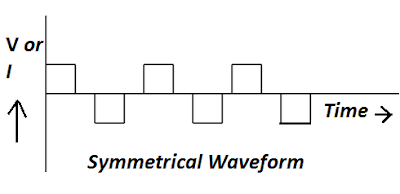Harmonics refers to the additional frequencies that are generated alongside the fundamental frequency of a waveform. These frequencies are typically unwanted and can cause distortion in the wave pattern. When harmonics are superimposed onto the fundamental waveform, the resulting wave pattern becomes distorted and may lead to issues in electronic equipment.
There are two types of circuits.
1. Linear Circuit
2. Non-linear circuit
In a linear circuit, the current follows the voltage. The current increases or decreases proportionally with the increase/decrease of voltage. The V-I characteristics of the devices are linear and called linear devices. An example of a linear device is a resistor. The linear devices follow the Ohm’s Law. If the voltage applied across the resistor is sinusoidal, the current flowing through it is also sinusoidal.
In a nonlinear device, the current flowing through the device does not follow Ohm’s law. The current flowing through the nonlinear devices does not follow the voltage waveform. If the applied voltage is sinusoidal, the current flowing through the non-linear device is non-sinusoidal.
At the time of charging of the transformer, the magnetizing current drawn by the transformer does not follow the sinusoidal voltage, and the current is non sinusoidal.
According to the Fourier series, the non-sinusoidal current can be resolved into the fundamental current and the integral multiples of the fundamental frequency. The integral multiples frequency of the fundamental frequency is called Harmonics.
What is a fundamental frequency?
The fundamental frequency of the sinusoidal waveform is the first harmonic order frequency, and it is equal to the supply frequency. The fundamental frequency is the lowest frequency f on which a complex waveform is built. In India and UK, the fundamental frequency is 50 Hz, and in the USA, the fundamental frequency of alternating voltage is 60 Hz.
A sinusoidal waveform is an alternating voltage or current which varies according to sin function.
i = Im sinwt
v = Vm Sinwt
w = 2Π f
Where,
v and i are the instantaneous values of the waveform
Vm, Im is the maximum value of the waveform
f is the lowest frequency or fundamental frequency
What is Harmonics?
Ideally, voltage and current waveform is sinusoidal. However, because of the increased popularity of electronic power devices and other non-linear loads, the waveform quite often becomes distorted. The distorted waveform can be resolved into fundamental and integral multiples of fundamental frequency according to the Fourier series. Thus, the distorted waveform will contain harmonics.
What is Harmonic Frequency?
If the fundamental frequency is f , the harmonic frequency will be 2f, 3f, 4f, 5f, 6f, and so on. If the frequency of the fundamental waveform is 50 Hz, the frequency of the harmonic waveform will be (2f= 2 x 50=100Hz), 3f= 3 x 50=150Hz, 200 Hz, 250Hz, 300Hz, 350 Hz, etc.
Harmonic order can be assigned according to the frequency of voltage or current waveform.
| Harmonic order | Frequency(Hz) |
| 2 | 100 |
| 3 | 150 |
| 4 | 200 |
| 5 | 250 |
| 6 | 300 |
| 7 | 350 |
| 8 | 400 |
| 9 | 450 |
2,4,6,8 order of harmonics are called even harmonics, and the 3,5,7,9 are called the odd harmonics. 3,6,9 order harmonics are called triplen harmonics.
If the current or voltage waveform is symmetrical about the x-axis, the even number of harmonics would be zero.

The converter and inverter waveform are symmetrical about the x-axis, which is why it contains only odd-order harmonics.
The instantaneous value of the harmonic frequency can be given as;
For second-order harmonics

For a Third order harmonics

For a fourth-order harmonics

The instantaneous value of the complex waveform can be expressed as follows.
E T= Ef (fundamental) + Eh (harmonics)

Further, the harmonics order can be represented as positive and negative sequence harmonics. The harmonic frequency that has the same phase sequence as the fundamental frequency is called positive sequence harmonics. The harmonic frequency, which has an opposite phase sequence of fundamental frequency, is called negative sequence harmonics.
| Harmonic Number | 1 | 2 | 3 | 4 | 5 | 6 | 7 | 8 | 9 | 10 | 11 | 12 |
| Phase Sequence | + | _ | 0 | + | _ | 0 | + | _ | 0 | + | _ | 0 |
3 thoughts on “Harmonics and Harmonic Frequency in AC Circuits”